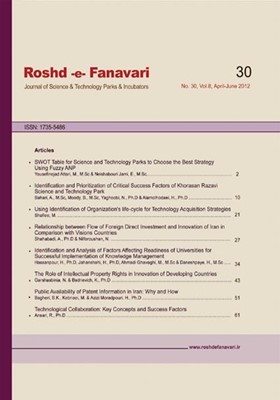-
-
List of Articles
-
Open Access Article
1 - SWOT table for science and technology parks to choose the best strategy using fuzzy ANP
Mahdi Yosefi Nezhad Atarry Ensiyeh Neyshaboory -
Open Access Article
2 - Identification and prioritization of critical success factor of Khorasan Razavis Science and Technology Park
Arman Bahari Behnush Mody Noormohammad Yaughobi Seyed Hasan Alamolhodaei -
Open Access Article
3 - Using Identification of Organization's life-cycle for Technology Acquisition Strategies
Mehrdad Shafiei -
Open Access Article
4 - Relationship between flow of foreign direct investment and innovation of Iran in comparison with prospective documented countries
Abolfazll Shahabadi Nima Nilofarforoushan -
Open Access Article
5 - Identification and analysis of factors affecting readiness of universities for successful implementation of knowledge management
Hossein Ali Hasan pour Hosein Jahanshahi Masoud Ahmadi Ghavaghy Hamzeh Danesh Payeh -
Open Access Article
6 - The Role of Intellectual Properties Rights in Innovation of Developing Countries
Neda Garshasbi niya Kamareddin Badry Vig -
Open Access Article
7 - Public availability of patent information in Iran: Why and How
Seyed Kamran Bagheri Maryam Kebriyaei Hamid Azizi moradpour -
Open Access Article
8 - Technological Collaboration :Key Concepts and Success Factors
Reza Ansari
-
The rights to this website are owned by the Raimag Press Management System.
Copyright © 2017-2025







